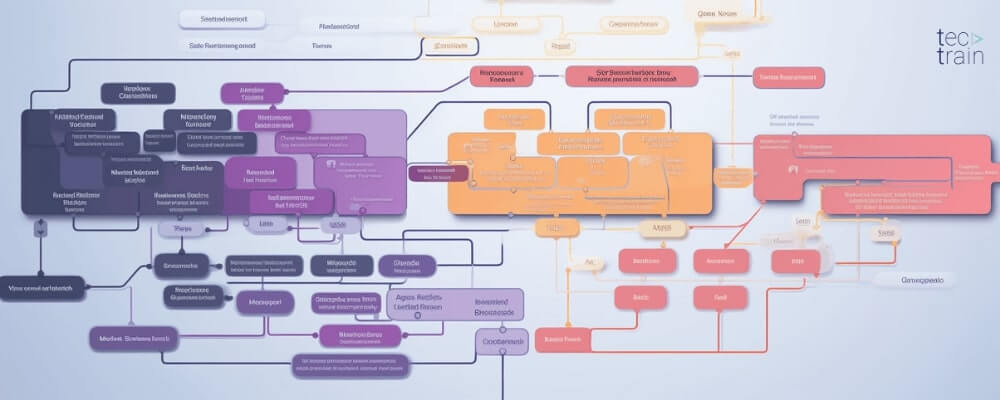Mastering Software Architecture Components
In the vast world of software development, the blueprint that dictates how various parts of an application interact is known as software architecture.
Much like how architects design buildings to ensure they're sturdy, functional, and aesthetically pleasing, software architects design the structure of software applications to make sure they run smoothly and efficiently.
This foundational step in the software development process has seen various approaches over the years. One such approach that has gained traction recently is the "component-based software architecture".
Let's delve into these concepts a bit more.
The Importance of Software Architecture in Software Development
Imagine building a house without a proper plan. The result would likely be chaotic, with rooms not fitting together and the structure possibly being unsafe.
Similarly, in software development, software architecture acts as that crucial plan. It provides a clear structure, ensuring that all parts of the software work harmoniously together. This not only makes the software more efficient but also easier to maintain and upgrade in the future.
The Rise of Component-Based Software Architecture
As software projects grew more complex, there was a need for a more modular approach. Enter "component-based software architecture". This approach breaks down software into smaller, reusable parts or "components". Each component has a specific function and can work independently.
Think of it like LEGO blocks. Each block (or component) has its own shape and purpose, but when combined, they can create a vast array of structures. This method has become popular because it allows for flexibility, easier updates, and a more organized way of building software.
Featured Resource
Software Architecture vs. Design: A Comprehensive Guide

Understanding the Essence of Software Architecture
At its core, software architecture is like the backbone of a software system. It's a plan that outlines how different parts of a software application will work together. Just as a blueprint is essential when constructing a building, software architecture is crucial in the software development lifecycle. It provides a clear roadmap for developers, ensuring that the software is built correctly from the start, saving time and resources in the long run.
Why Software Architecture Matters for Scalability, Maintainability, and Performance?
Imagine a bustling city. If the roads and infrastructure aren't planned well, traffic jams can become a common sight, and expanding the city can be a nightmare. Similarly, software architecture ensures that as a software application grows (scalability), it doesn't get "traffic jams" or slowdowns (performance).
It also ensures that if something breaks or needs an update, it can be fixed without tearing down the entire system (maintainability). In simple terms, good architecture makes sure software runs smoothly today and can easily adapt to the needs of tomorrow.

Exploring Component-Based Software Architecture
Component-based software architecture is a bit like building with toy blocks. Each block, or "component", is a standalone piece that has a specific function. Instead of creating a software application as one big piece, developers break it down into these smaller, independent components.
These components can work on their own, but when combined, they create a complete software system. This approach is grounded in the principle of modularity, where each part does its job without relying too heavily on the others.
Why Choose a Component-Based Approach?
Opting for a component-based method comes with some great perks. First, it makes things simpler. If one component has an issue, you can fix or replace just that part without disturbing the rest.
Second, it's cost-effective. Since these components are reusable, developers can use the same piece in multiple projects, saving time and effort.
Lastly, it speeds up the development process. Teams can work on different components simultaneously, making the whole process more efficient and collaborative. In short, it's like having a set of versatile building blocks that can be rearranged and reused as needed.
Key Components of Software Architecture
- Data Components
- Middleware Components
- User Interface Components
- Service Components
Data Components: These are the software's storage units, safeguarding and organizing information to ensure it remains consistent and intact.
Middleware Components: Acting as the software's messengers, they facilitate smooth communication between different parts, ensuring all elements work in sync.
User Interface Components: They shape the user's experience, making sure interactions are intuitive and straightforward.
Service Components: The behind-the-scenes workers, handle core tasks like processing data and executing user commands efficiently.
Component Diagram in Software Architecture
In the world of software, visual aids can be incredibly helpful. One such tool is the "component diagram". It's a bit like a map for software, showing how different parts (or components) of a software system connect and interact. By looking at this diagram, developers can get a clear picture of the software's structure and how its pieces fit together.
Imagine trying to assemble a puzzle without the picture on the box. Tricky, right?
Component diagrams are that picture for software developers. They visually showcase how different software components relate to each other, highlighting connections, dependencies, and interactions. This makes it easier to understand the software's overall layout and flow.
These diagrams are not just for show; they offer real value. During the design phase, they help teams plan out the software's structure efficiently. And when it comes to documentation, component diagrams serve as a reference point, making it simpler for new team members to understand the system or for existing members to make updates. In essence, they act as a guiding star, ensuring everyone is on the same page.

Advantages of Component-Based Software Architecture
- Modularity
- Reusability
- Scalability
- Improved Testing
Modularity: Like toy blocks, individual components can be easily updated or replaced without affecting the whole system.
Reusability: Components act like versatile tools, usable across multiple projects, saving time and ensuring consistency.
Scalability: As software needs to grow, adding or tweaking components is straightforward, avoiding a complete overhaul.
Improved Testing: Each component can be tested separately, ensuring each piece works well, leading to more reliable software overall.
Many of today's popular software and applications have embraced component-based architecture. For instance, Microsoft's Windows operating system uses this approach, breaking down various functionalities into components. Similarly, web applications like Facebook and Gmail are built using components, allowing them to efficiently manage features like chat, notifications, and emails separately.
By adopting a component-based structure, these software and applications have gained flexibility and agility. For instance, when Facebook wants to update its chat feature, it can do so without affecting the entire platform.
This means faster updates and fewer disruptions for users. Similarly, for Windows, if there's an update for its media player or security features, it can be rolled out without overhauling the entire operating system. This approach not only streamlines development but also ensures a smoother user experience.
Featured Resource
Software Architecture in Practice: Real-World Applications
Conclusion
Grasping the intricacies of software architecture components is like understanding the foundation of a building; it's crucial for stability and longevity. The modular nature of component-based software architecture offers flexibility, making updates and improvements a breeze.
For anyone embarking on a software project, diving deeper into this approach can be a game-changer, ensuring not only a smoother development process but also a more adaptable and resilient end product. So, take a moment to consider the building blocks of your software; it's an investment worth making.
Elevate your understanding of software architecture to the next level with hands-on training and certifications. At tectrain Academy, we offer a curated selection of courses and workshops tailored to your needs.
Whether you're a beginner eager to grasp the basics or a seasoned professional looking to refine your skills, our offerings provide the perfect platform. Dive deeper into the world of software architecture and equip yourself with the knowledge and credentials to stand out. Don't just learn; transform your expertise with tectrain. Explore our courses today!









